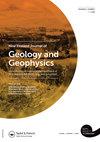A time-dependent seismic hazard model following the Kaikōura M7.8 earthquake
IF 1.9
4区 地球科学
Q1 GEOLOGY
New Zealand Journal of Geology and Geophysics
Pub Date : 2023-02-15
DOI:10.1080/00288306.2022.2158881
引用次数: 1
Abstract
ABSTRACT Following the 2016 M7.8 Kaikōura earthquake, a time-varying seismic hazard model (KSHM) was developed to inform decision-making for the reinstatement of road and rail networks in the northern South Island. The source model is the sum of a gridded 100-year earthquake clustering model and an updated fault source model. The gridded model comprises long-term, medium-term and short-term components. The 100-year gridded model is constructed as the sum of 100 annual forecasts. A discounting method trades off expected earthquake occurrences of the distant future against those of the near future. The fault source model includes updates to account for newly revealed faults that ruptured in the Kaikōura earthquake and other recently obtained new information, and new time-varying probabilities of rupture for four fault segments. Two different characterisations of the Hikurangi subduction interface are incorporated via a logic tree, with weights determined by an expert panel. A suite of ground motion prediction equations contribute to a logic tree in order to account for epistemic uncertainties in source modelling for each of four tectonic region types. Here, we compare the resulting hazard estimates with the 2010 National Seismic hazard Model and recorded motions in past New Zealand and global earthquakes.Kaikōura 7.8级地震后的时变地震灾害模型
在2016年Kaikōura里氏7.8级地震发生后,研究人员开发了一个时变地震灾害模型(KSHM),为南岛北部公路和铁路网络的恢复提供决策依据。震源模型是网格化的百年地震聚类模型和更新后的断层震源模型的总和。网格模型包括长期、中期和短期三个部分。100年网格模型是由100个年度预测的总和构成的。贴现法将遥远未来的地震预测与近期的地震预测进行比较。断层源模型包括更新,以考虑在Kaikōura地震中新发现的破裂断层和其他最近获得的新信息,以及四个断层段的新的时变破裂概率。Hikurangi俯冲界面的两种不同特征通过逻辑树合并,权重由专家小组确定。一套地震动预测方程有助于逻辑树,以便在四种构造区域类型的震源建模中考虑认识上的不确定性。在这里,我们将得出的危险性估计与2010年国家地震危险性模型进行了比较,并记录了过去新西兰和全球地震的运动。
本文章由计算机程序翻译,如有差异,请以英文原文为准。
求助全文
约1分钟内获得全文
求助全文
来源期刊
CiteScore
5.10
自引率
27.30%
发文量
34
审稿时长
>12 weeks
期刊介绍:
Aims: New Zealand is well respected for its growing research activity in the geosciences, particularly in circum-Pacific earth science. The New Zealand Journal of Geology and Geophysics plays an important role in disseminating field-based, experimental, and theoretical research to geoscientists with interests both within and beyond the circum-Pacific. Scope of submissions: The New Zealand Journal of Geology and Geophysics publishes original research papers, review papers, short communications and letters. We welcome submissions on all aspects of the earth sciences relevant to New Zealand, the Pacific Rim, and Antarctica. The subject matter includes geology, geophysics, physical geography and pedology.

 求助内容:
求助内容: 应助结果提醒方式:
应助结果提醒方式:


